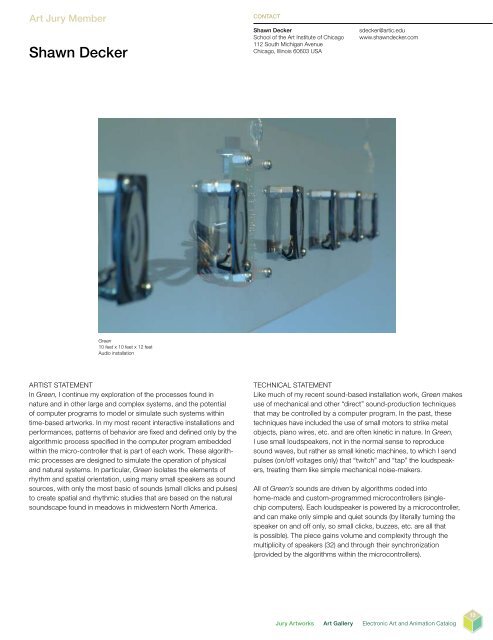Intersections - Nguyen Dang Binh
Intersections - Nguyen Dang Binh
Intersections - Nguyen Dang Binh
Create successful ePaper yourself
Turn your PDF publications into a flip-book with our unique Google optimized e-Paper software.
Art Jury Member<br />
Shawn Decker<br />
Green<br />
10 feet x 10 feet x 12 feet<br />
Audio installation<br />
ARTIST STATEMENT<br />
In Green, I continue my exploration of the processes found in<br />
nature and in other large and complex systems, and the potential<br />
of computer programs to model or simulate such systems within<br />
time-based artworks. In my most recent interactive installations and<br />
performances, patterns of behavior are fixed and defined only by the<br />
algorithmic process specified in the computer program embedded<br />
within the micro-controller that is part of each work. These algorithmic<br />
processes are designed to simulate the operation of physical<br />
and natural systems. In particular, Green isolates the elements of<br />
rhythm and spatial orientation, using many small speakers as sound<br />
sources, with only the most basic of sounds (small clicks and pulses)<br />
to create spatial and rhythmic studies that are based on the natural<br />
soundscape found in meadows in midwestern North America.<br />
CONTACT<br />
Shawn Decker<br />
School of the Art Institute of Chicago<br />
112 South Michigan Avenue<br />
Chicago, Illinois 60603 USA<br />
sdecker@artic.edu<br />
www.shawndecker.com<br />
TECHNICAl STATEMENT<br />
like much of my recent sound-based installation work, Green makes<br />
use of mechanical and other “direct” sound-production techniques<br />
that may be controlled by a computer program. In the past, these<br />
techniques have included the use of small motors to strike metal<br />
objects, piano wires, etc. and are often kinetic in nature. In Green,<br />
I use small loudspeakers, not in the normal sense to reproduce<br />
sound waves, but rather as small kinetic machines, to which I send<br />
pulses (on/off voltages only) that “twitch” and “tap” the loudspeakers,<br />
treating them like simple mechanical noise-makers.<br />
All of Green’s sounds are driven by algorithms coded into<br />
home-made and custom-programmed microcontrollers (single-<br />
chip computers). Each loudspeaker is powered by a microcontroller,<br />
and can make only simple and quiet sounds (by literally turning the<br />
speaker on and off only, so small clicks, buzzes, etc. are all that<br />
is possible). The piece gains volume and complexity through the<br />
multiplicity of speakers (32) and through their synchronization<br />
(provided by the algorithms within the microcontrollers).<br />
Jury Artworks Art Gallery Electronic Art and Animation Catalog

















